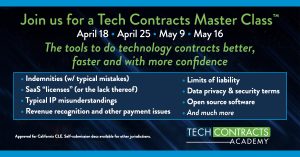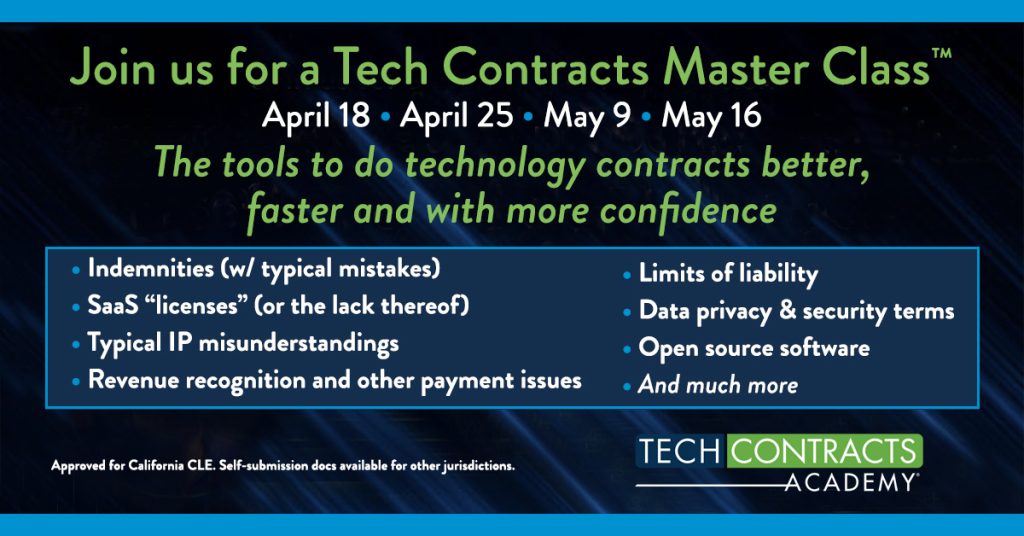This article has been updated with a new one: “Don’t grant a license to SaaS, AIaaS, or Other Cloud Services.”
Many software-as-a-service (SaaS) contracts grant a “license” to the vendor’s software. That’s a mistake. Licenses authorize making copies of on-premise software. Customers don’t copy SaaS, so they don’t need a license. And if you’re the vendor, a license can hurt you. [I’ll explain below – but for a deeper dive, please join us for the Tech Contracts Master Classes™.]
SaaS Customers Don’t Copy Software
 The confusion stems from the role of “software” in software-as-a-service. You can cut through that confusion by asking what the customer will do with the software. If the customer puts a copy on a computer — if it’s on-premise software — the contract needs a license. Copyright law gives the software’s owner a monopoly on the right to copy it, so the customer needs a copyright license to make copies. The rule is the same whether the customer owns the computer receiving the copy or uses computers provided by its data center vendor.
The confusion stems from the role of “software” in software-as-a-service. You can cut through that confusion by asking what the customer will do with the software. If the customer puts a copy on a computer — if it’s on-premise software — the contract needs a license. Copyright law gives the software’s owner a monopoly on the right to copy it, so the customer needs a copyright license to make copies. The rule is the same whether the customer owns the computer receiving the copy or uses computers provided by its data center vendor.
In a SaaS deal, on the other hand, the customer does not put software on a computer — or copy it at all. The software sits on the vendor’s computers, and the customer just accesses it. With no copies, copyright plays no role in the promise of services, so the customer doesn’t need a copyright license. Rather, it needs a simple permission: “During the term of this Agreement, Customer may access and use the System.” (For more sample language, see The Tech Contracts Handbook, Chap. I.E.1, as well as the examples in our clauses archive.)
Incidentally, some would say the customer gets a service, not software, in a SaaS deal — as implied by “software-as-a-service.” The term “service,” however raises its own set of problems, leading to confusion between SaaS and professional services. [See my 2022 article, “Cloud Services Are Neither Products nor Services.”) I think the language above (in green) works better. And if you want a handy name for the transaction, replacing “license” (and “service”), I like “subscription.” So the example clause above could read, “During the Subscription Period, Customer may access and use the System.”
Trouble for SaaS Vendors
Some pundits argue that a “license to use” SaaS just means permission and does not grant a copyright license. But why take the risk, since a SaaS contract using the word “license” could hurt the vendor in at least four ways?
- Patent License: Contracts use “license” to grant patent rights. So a customer could argue that its SaaS “license” gives rights under the vendor’s patents — rights to build and sell its own software similar to the SaaS system.
- Right to a Copy: In a dispute, a customer with “license” could demand a copy of the software — code behind the SaaS. Maybe an ex-customer claims wrongful termination of its contract, for instance, and argues that it now needs a copy of the vendor’s software to manage minimize losses. Licensing language could support that argument.
 Copyleft Open Source Distribution: Many SaaS systems include “copyleft” open source software (a.k.a. “viral” open source software, though the nickname is misleading). Copyleft code is provided to software companies on the condition that, if the company distributes its own product, it must distribute it as open source software. Generally, copyleft rules don’t apply to SaaS vendors because they don’t distribute: they don’t give customers copies of their software. But any suggestion that customers have a right to copies could support an argument that copyleft applies. Using the word “license” creates such a suggestion. (For more on copyleft, click here.)
Copyleft Open Source Distribution: Many SaaS systems include “copyleft” open source software (a.k.a. “viral” open source software, though the nickname is misleading). Copyleft code is provided to software companies on the condition that, if the company distributes its own product, it must distribute it as open source software. Generally, copyleft rules don’t apply to SaaS vendors because they don’t distribute: they don’t give customers copies of their software. But any suggestion that customers have a right to copies could support an argument that copyleft applies. Using the word “license” creates such a suggestion. (For more on copyleft, click here.)- Bankruptcy: Intellectual property licenses generally continue even after the vendor files bankruptcy. So if the vendor goes through reorganization, customers with “license” in their contracts could argue that they keep their rights to the SaaS.
Combination Deals
Of course, your deal may involve both SaaS and on-premise software. A SaaS vendor may provide its main offering online but also provide an application for customers’ computers — an on-premise app that helps those machines talk to the online service. Don’t let that confuse you. What you need there is a software license covering that one installed on-premise app, wrapped in the larger SaaS subscription contract. The license addresses the installed app only, not the SaaS system on the vendor’s computers.
* * *
Looking to learn more? Our next Master Class series starts April 18, 2023. Four classes, two hours each, conveniently virtual, with live Q&A. Registration and more information is available here.
And, the 3rd edition of David Tollen’s best-seller, The Tech Contracts Handbook, is available to order (and review) from Amazon here, or purchase directly from its publisher, the American Bar Association, here.
For a related article (noted above), see “Cloud Services are Neither Products nor Services.”
Want to do tech contracts better, faster, and with more confidence? Check out our training offerings here: https://www.techcontracts.com/training/. Tech Contracts Academy has options to fit every need and schedule: Comprehensive Tech Contracts Master Classes™ (four on-line classes, two hours each), topical webinars (typically about an hour), customized in-house training (for just your team).
David Tollen is the founder of Tech Contracts Academy and our primary trainer. An attorney and also the founder of Sycamore Legal, P.C., a boutique IT, IP, and privacy law firm in the San Francisco Bay Area, he also serves as an expert witness in litigation about software licenses, cloud computing agreements, and other IT contracts.
This article is an update of an earlier version, posted in 2011.
© 2018, 2022, 2023 by Tech Contracts Academy, LLC. All rights reserved.
Thank you to Pixabay.com for great, free stock photos!


 Copyleft Open Source Distribution: Many SaaS systems include “copyleft” open source software (a.k.a. “viral” open source software, though the nickname is misleading). Copyleft code is provided to software companies on the condition that, if the company distributes its own product, it must distribute it as open source software. Generally, copyleft rules don’t apply to SaaS vendors because they don’t distribute: they don’t give customers copies of their software. But any suggestion that customers have a right to copies could support an argument that copyleft applies. Using the word “license” creates such a suggestion. (For more on copyleft,
Copyleft Open Source Distribution: Many SaaS systems include “copyleft” open source software (a.k.a. “viral” open source software, though the nickname is misleading). Copyleft code is provided to software companies on the condition that, if the company distributes its own product, it must distribute it as open source software. Generally, copyleft rules don’t apply to SaaS vendors because they don’t distribute: they don’t give customers copies of their software. But any suggestion that customers have a right to copies could support an argument that copyleft applies. Using the word “license” creates such a suggestion. (For more on copyleft, 